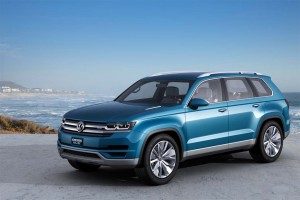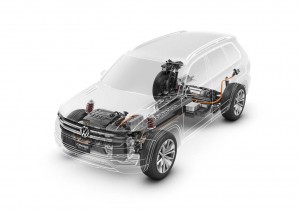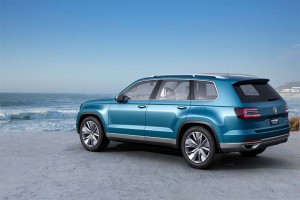Volkswagen has promised to double the range of SUVs and crossovers it currently offers – and a critical addition to the line-up is making its first appearance at the Detroit Auto Show this week. Dubbed CrossBlue, the midsize SUV concept has been developed specifically for the North American market.
Significantly, the prototype on display at the 2013 North American International Auto Show features VW’s new diesel-electric plug-in hybrid drivetrain, a technology the maker boasts can deliver a mix of performance, range and segment-leading fuel economy.
Whether the diesel hybrid technology will actually be offered in the U.S. market remains to be seen, but a production version of the CrossBlue Concept is expected to reach showrooms in the near future. Company officials say it is critical if they hope to meet their target of setting an all-time sales record in the American market before the end of the decade.
“The CrossBlue concept is exactly the right type of vehicle for the U.S. market,” said Jonathan Browning, President and CEO, Volkswagen Group of America. “It combines a truly versatile interior layout with sophisticated Volkswagen design, to give a unique and supremely stylish offering in this segment. Moreover, the vehicle showcases our innovative German powertrain engineering and the bandwidth of the new MQB architecture.”
While designed in Germany under the guidance of VW’s styling chief Walter da Silva, the CrossBlue aims to balance two distinctive American niches, blending what the maker describes as the “masculine character of an SUV…with the spaciousness and flexibility of a minivan.”
In fact, it appears to be aimed at serving as an alternative to the long-awaited and ultimately abandoned replacement for the legendary Volkswagen Microvan. The maker has tried repeatedly to come up with a modern version – such as the ill-fated Bulli concept — but has repeatedly failed to find a design that would both meet modern safety standards while also clicking with American buyers.
What remains to be seen is whether the production version of the CrossBlue would serve as a replacement for the slow-selling Routan, the VW-badged minivan currently being produced by Chrysler.
The CrossBlue Concept boasts six individual seats and 12 airbags, as well as a variety of other advanced safety features. The cabin is both spacious and well-appointed, with the use of wood, leather and chrome trim more in line with an Audi model than the vehicle Volkswagen.
The high-tech focus can be seen in almost every details of the CrossBlue, from LED taillights that form the letter, “E,” to the onboard infotainment package that includes a Fender audio system and video players that allow rear passengers to watch their own programming.
The instrument cluster, meanwhile, readily displays the various driving modes, Eco shown with a blue background, Sport in red.
But it’s the diesel plug-in hybrid drivetrain that is likely to generate much of the buzz about the VW CrossBlue Concept. It pairs a compact, 190-horsepower clean diesel with twin electric motors, one on the front axles, the other on the rear, creating an electric all-wheel drive system that VW has dubbed “propshaft by wire.”
All told, the package can generate 305 horsepower and 516 lb-ft of torque, and that’s enough to launch the midsize crossover from 0 to 60 in just 7.2 seconds. Even so, it is also tentatively rated at 35 mpg as a conventional hybrid, and 89 MPGe in plug-in mode.
Range is estimated at 14 miles using just the CrossBlue’s lithium-ion battery pack, and 661 miles when also drawing from a full tank of diesel.
Several makers now offer a diesel-hybrid option in Europe, but the idea of taking things the next step, with a plug-in system, is something that VW and Volvo are also considering.
The challenge is likely to be one of cost. Even basic hybrids carry a premium running into the thousands of dollars and plug-ins add several times that much to a vehicle’s price tag. Diesels, meanwhile, also carry a significant price disadvantage.
While such a system might still make economic sense in Europe, where motorists are currently paying as much as $9 a gallon for gasoline, it would be a much harder sell in the U.S. So, while the CrossBlue Concept is likely to launch here with a more conventional drivetrain, industry analysts caution that the diesel plug-in system is more likely to make it into production on the other side of the Atlantic.




The front end styling is mediocre, but Americans love SUVs.
A Diesel hybrid should get outstanding mpg and this will help car makers try to meet the absurd 54.5 mpg CAFE standards that car makers are simply unable to meet. Just because Obama and the EPA pull a number outta of their orifice, doesn’t mean the technology exists to deliver 54.5 mpg in reality.
The VW, Audi, BMW and Mercedes Blue Diesels are world class turbo Diesel engines in their own right. They deliver impressive mpg even with the stictest Diesel emissions standards in the world unique only to the U.S. – who is doing all they can to prevent consumers from enjoying the same clean Diesel technology that the rest of the world enjoys.
It will be very, very interesting to see how some of the new US diesels will fare this year, notably the Chevy Cruze, Mazda6, Jeep Grand Cherokee and various Audis. Should they generate real market enthusiasm, I anticipate a lot more diesels to come here.
Paul A. Eisenstein
Publisher, TheDetroitBureau.com